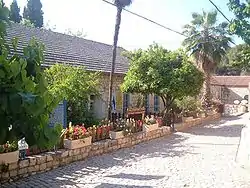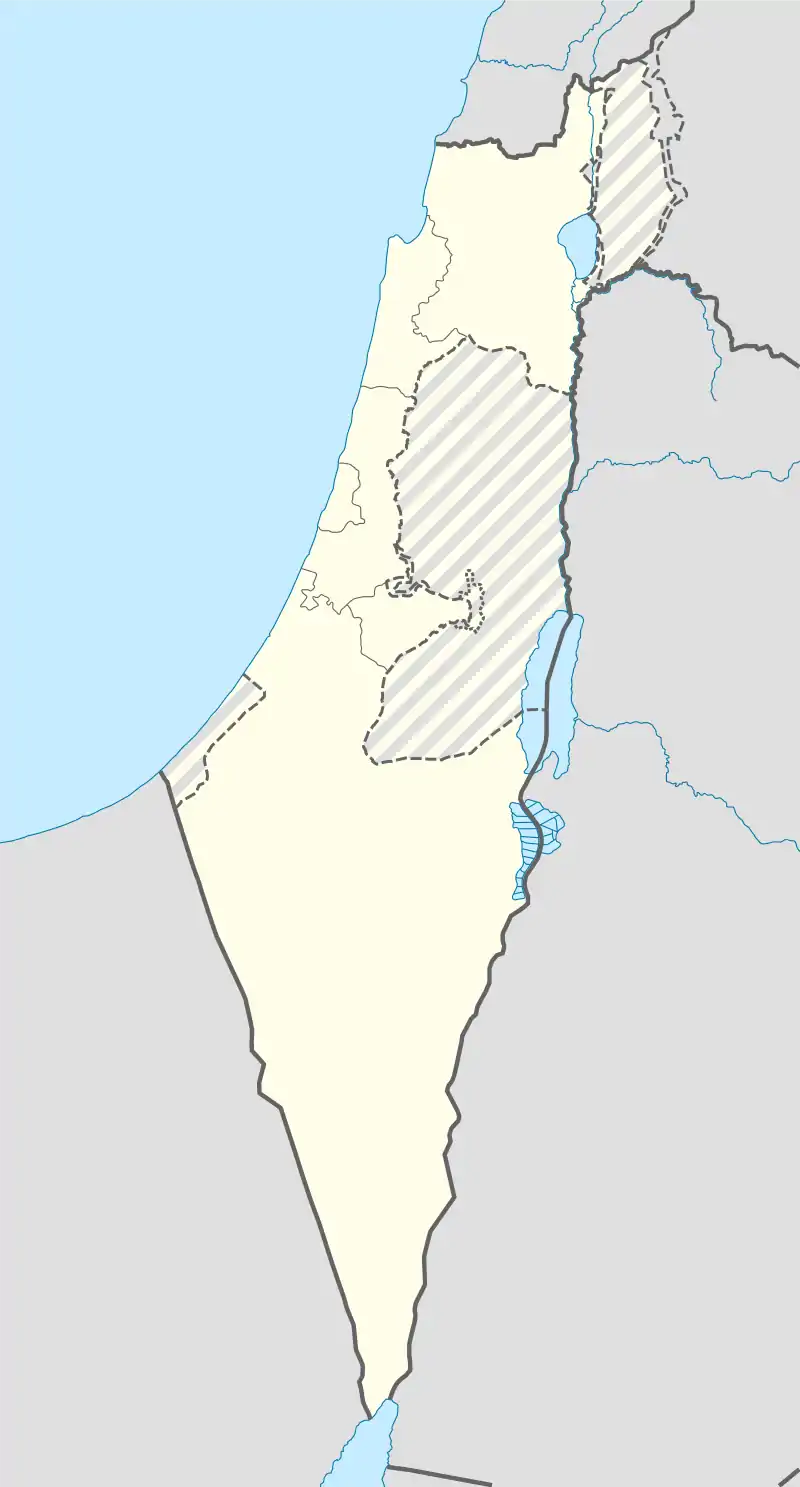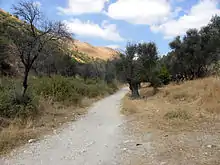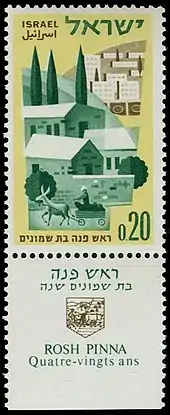Rosh Pinna
Rosh Pina or Rosh Pinna (Hebrew: רֹאשׁ פִּנָּה, lit. Cornerstone) is a town and local council in the Korazim Plateau in the Upper Galilee on the eastern slopes of Mount Kna'an in the Northern District of Israel. It was established as Gei Oni in 1878 by local Jews from Safed but was abandoned. In 1882, thirty Jewish families who had immigrated from Romania reestablished settlement as a moshavah called Rosh Pinna. The town is one of the oldest Zionist settlements in Israel. In 2019 it had a population of 3,148.
Rosh Pina
| |
|---|---|
| Hebrew transcription(s) | |
| • ISO 259 | Roˀš Pinna |
| • Also spelled | Rosh Pina (official) Roch Pinna, Rosh Pinah (unofficial) |
 | |
 Rosh Pina  Rosh Pina | |
| Coordinates: 32°58′12″N 35°32′32″E | |
| Country | |
| District | Northern |
| Founded | 1878 |
| Government | |
| • Head of Municipality | Moti Hatiel (by 2018 Israeli municipal elections) |
| Area | |
| • Total | 17,569 dunams (17.569 km2 or 6.783 sq mi) |
| Population (2019)[1] | |
| • Total | 3,148 |
| • Density | 180/km2 (460/sq mi) |
| Name meaning | Cornerstone |

Geography
Rosh Pinna is located north of the Sea of Galilee, on the eastern slopes of Mount Kna'an, approximately 2 km (1 mi) east of the city of Safed, 420 m (1,378 ft) above sea level, latitude north 32° 58', longitude east 35° 31'. North of Rosh Pina is Lake Hula, which was a swamp area drained in the 1950s.
History
Around 1878, the Arab village of al-Ja'una sold half its lands, about 2,500 dunum, to Jews from Safed in order to fund the emigration of some of the villagers to the Hauran.[2] Led by Elazar Rokah, the Jews moved into al-Ja'una, living among the Arabs for fear of being unable to cope with Bedouin raids on their own.[2] They called their settlement Gei Oni ("Valley of my Strength") as a Hebrew adaption of the Arabic name.[3] After one year of good harvests, a year of drought saw the Arabs mortgage their lands to money lenders, but the Jews were unwilling to do the same and left.[2]
In 1882, the settlement was renewed as a moshavah by immigrants from Romania, who named it Rosh Pinna ("cornerstone") after Psalm 118:22: "The stone which the builders rejected has become the cornerstone".[3][2]
Rosh Pinna was one of the first modern Jewish agricultural settlements in the history of the Land of Israel, then part of the Turkish Ottoman Empire. In 1883, it became the first Jewish settlement in the Land of Israel to come under the patronage of the Baron Edmond James de Rothschild. Rothschild's agent Joshua Ossovetski expanded the settlement with more land from Safed and Ja'una.[2] Rosh Pinna had good relations with Ja'una, even establishing a modern Arab school there, but had some serious clashes with the el-Zangariya Bedouin tribe.[2]
Moshe David Shub (born 1854 in Moineşti; died 1938 in Jerusalem) had been sent ahead to find and purchase an appropriate piece of land. Born as Moşe David Iancovici, in Palestine he became known as: שו"ב, Shub, a Hebrew abbreviation of the name of his profession, שוחט ובודק, read "shochet u-bodék", butcher and examiner [of kosher meat]; ("shuv" has also the Hebrew meaning of "once again", or "return!", an allusion to the main principle of Zionism; in Hebrew the same letter [ב] is used for "v" and "b").
Laurence Oliphant collected funds for Rosh Pina from Christadelphians and other sympathizers in Britain.[4] He wrote about his visit to Rosh Pina in 1886:
"Jauna, which was the name of the village to which I was bound, was situated about three miles (5 km) from Safed, in a gorge, from which, as we descended it, a magnificent view was obtained over the Jordan valley, with the Lake of Tiberias lying three thousand feet below us on the right, and the waters of Merom, or the Lake of Huleh, on the left. The intervening plain was only waiting for development. The new colony has been established about eight months, the land having been purchased from the Moslem villagers, of whom twenty families remained, who lived on terms of perfect amity with the Jews. These consisted of twenty-three Roumanian and four Russian families, numbering in all one hundred and forty souls. The greater number were hard at work on their potato-patches when I arrived, and I was pleased to find evidences of thrift and industry. A row of sixteen neat little houses had been built, and more were in process or erection. Altogether this is the most hopeful attempt at a colony which I have seen in Palestine. The colonists own about a thousand acres of excellent land, which they were able to purchase at from three to four dollars an acre. The Russians are establishing themselves about half a mile from the Roumanians, as Jews of different nationalities easily get on well together. They call the colony Rosch Pina, or "Head of the Corner," the word occurring in the verse, "The stone which the builders rejected, the same is become the head of the comer."[5]

According to a census conducted in 1922 by the British Mandate authorities, Rosh Pinna had a population of 468 inhabitants, consisting of 460 Jews, 4 Muslims and 4 Christians.[6]
 Rosh Pinna 1926
Rosh Pinna 1926 Rosh Pinna 1937
Rosh Pinna 1937 Customs House, Rosh Pinna. January 1939
Customs House, Rosh Pinna. January 1939 Yiftach Brigade Camp Philo, Rosh Pinna, 1948
Yiftach Brigade Camp Philo, Rosh Pinna, 1948 Camp Philo, Rosh Pinna. 1948
Camp Philo, Rosh Pinna. 1948 Members of the Yiftach Brigade arriving at Camp Philo, Rosh Pinna. 1948
Members of the Yiftach Brigade arriving at Camp Philo, Rosh Pinna. 1948 Philo Camp "D" Company 1st Battalion Yiftach Brigade prior to fighting around al-Malikiyya, 1948
Philo Camp "D" Company 1st Battalion Yiftach Brigade prior to fighting around al-Malikiyya, 1948 Yiftach Brigade take over Rosh Pinna police station during Operation Yiftach, 1948
Yiftach Brigade take over Rosh Pinna police station during Operation Yiftach, 1948
Discovery of wild emmer
Botanist Aaron Aaronsohn, while trekking around Rosh Pina during his 1906 field trip, discovered wild-growing emmer (Triticum dicoccoides), whom he considered to be the "mother of wheat", an important find for agronomists and historians of human civilization. Geneticists have proven that wild emmer is indeed the ancestor of most domesticated wheat strands cultivated on a large scale today[7] with the exception of durum wheat; einkorn, a different ancient species, is currently just a relict crop.
Education
Rosh Pina had the first Hebrew School in 1899.[8]
Transportation
Ben Ya'akov Airport (Mahanaim Airport) is located 2.1 km (1 mi) away from Rosh Pina.
Medical facilities
The Mifne Center,[9] which means turning point, a program for the treatment of autism spectrum disorder, is situated in Rosh Pina.[10]
Landmarks
- Mitzpe HaYamim, a world-class spa, is located on a mountainside in Rosh Pina. Amenities include a range of health and cosmetic treatments, an art gallery where guests can view artists at work, art workshops and an organic garden.
- The House of Dignitaries is a structure built in 1882 and used as a center of administration and finance for Rosh Pina and other towns in the Galilee region. From this building, a loudspeaker was used to broadcast the local news.
- An ancient synagogue, which was commissioned by the Baron, also has been preserved.
- The Mer house was the home of Professor Gideon Mer, an expert on malaria, epidemiologist and an important contributor to the eradication of malaria in the 1930s.[11] The house presents a room dedicated to his memory and an exhibit of ancient items from various periods, such as old plows, laboratory equipment and textbooks.
- PICA House provides an audio-visual presentation that tells the story of Rosh Pina. PICA House served as an administrative center and residence for Baron Rothschild’s clerks, advisors, and agricultural counselors.
- The Baron Rothschild' gardens. The gardens were designed by a French landscape architect and planted in 1886. Many plants such as Bougainvillea and pine trees were brought from France.
- The grave of Honi HaM'agel, a Jewish scholar, is located on the outskirts of Hatzor HaGlilit, a few kilometers from Rosh Pina.
- "Nimrod Lookout", a green spot with water views as seen from the viewpoint flowing through, facing the landscapes of the Hula Valley, the Golan Heights and Mount Hermon, will be built in the Pioneers National Restoration Site in old Rosh Pina.
Notable residents
- Ami Assaf (1903–63), politician
- Ehud Banai (born 1953), singer and songwriter
- Meir Dagan (born 1945), former Director General of Mossad
- Arna Mer-Khamis (1929–95), political and human rights activist
References
- "Population in the Localities 2019" (XLS). Israel Central Bureau of Statistics. Retrieved 16 August 2020.
- Arieh L. Avneri (1984). The Claim of Dispossession. Yad Tabenkin; Transaction Books. pp. 85–86.
- Efraim Orni; Shaked Gilboa. "Rosh Pinnah". In Fred Skolnik (ed.). Encyclopedia Judaica. 17 (2 ed.). Thomson Gale. p. 466.
- Abstract: Laurence Oliphant's interest in the development of Jewish settlement in Ottoman Palestine, preceded his interest in the plight of Jewish communities in Eastern Europe. While his intensive involvement in these matters is well known, especially in modern Israel, the fact that the funds for his largesse were contributed by the Christadelphian Brotherhood has not previously been published. The present article brings to light material from the archives of this sect, and thus, too, the motivation behind these efforts. Amit, Thomas. Laurence Oliphant: Financial Sources for his Activities in Palestine in the 1880s Palestine Exploration Quarterly, Volume 139, Number 3, November 2007, pp. 205–212(8)
- Laurence Oliphant. "Extract from page 71 of "Haifa or Life in Modern Palestine"". Archived from the original on 2007-12-13. Retrieved 2018-09-10.
- "Palestine Census ( 1922)" – via Internet Archive.
- Peng, Junhua; Korol, Abraham B.; Fahima, Tzion; Röder, Marion S.; Ronin, Yefim I.; Li, Youchun C.; Nevo, Eviatar (October 1, 2000). "Molecular Genetic Maps in Wild Emmer Wheat, Triticum dicoccoides: Genome-Wide Coverage, Massive Negative Interference, and Putative Quasi-Linkage". Genome Research. 10 (10): 1509–1531. doi:10.1101/gr.150300. PMID 11042150 – via genome.cshlp.org.
- "Rosh Pinna". Crwflags.com. Retrieved September 24, 2011.
- "The Mifne Center". Mifne-autism.com. Retrieved September 24, 2011.
- "The Mifne Center". Ujcna.org. Archived from the original on April 16, 2013. Retrieved September 24, 2011.
- "Rosh Pina". Stateofisrael.com. Retrieved September 24, 2011.
External links
![]() Media related to Rosh Pina at Wikimedia Commons
Media related to Rosh Pina at Wikimedia Commons
- Rosh Pina State of Israel
- Ben Ya'akov Airport
- The Historic Settlement

.svg.png.webp)